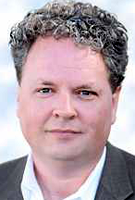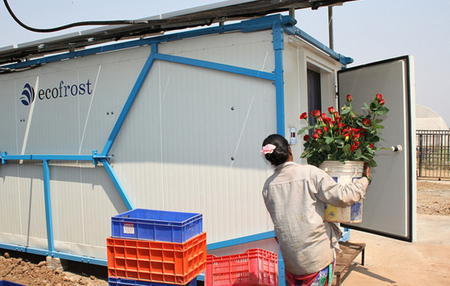 The Phase Change Matters e-mail newsletter is a weekly summary of the latest news and research on phase change materials and thermal energy storage. To subscribe, visit www.puretemp.com/subscribe. For more frequent updates, follow @puretemp on Twitter or visit the Phase Change Matters blog, www.puretemp.com/pcmatters.
The Phase Change Matters e-mail newsletter is a weekly summary of the latest news and research on phase change materials and thermal energy storage. To subscribe, visit www.puretemp.com/subscribe. For more frequent updates, follow @puretemp on Twitter or visit the Phase Change Matters blog, www.puretemp.com/pcmatters.
PCM STANDARDS
Alexium says it’s working to establish wide acceptance of new testing protocol
Alexium International Group Ltd. announced in April that it had developed an “innovative thermal analytical testing methodology” to measure the cooling capacity of PCM-enhanced products used in pillows, sheets and mattresses.
 Alexium, based in Greer, S.C., and Perth, Australia, makes flame-retardant and PCM-enhanced fabric treatments. Dr. Robert Brookins, Alexium’s executive vice president of research and development and newly appointed interim CEO, responded to questions about the new protocol this week.
Alexium, based in Greer, S.C., and Perth, Australia, makes flame-retardant and PCM-enhanced fabric treatments. Dr. Robert Brookins, Alexium’s executive vice president of research and development and newly appointed interim CEO, responded to questions about the new protocol this week.
A: “At this point, the protocol has been openly shared with people in the industry, and Alexium has educated them on how to use this method. This work has been in conjunction with our customers. For more general usage, Alexium is working to introduce this as a formal test method through a standards organization.”
Q: What retail pillows were evaluated (by type, if not by brand)? Do they contain microencapsulated phase change materials?
A: “All of the pillows were purchased from general retail stores and were all based on the application of the PCM to a textile component. Based on the marketing included with the pillows and the apparent method of application, microencapsulated phase change materials were used on all of these. To clarify, none of the products specifically stated that PCMs were used.”
Q: What is the MPCM load in each of the four Alexium-treated pillows shown in the chart?
A: “We supply the analytical data as a testament to performance, but do not provide public information about the specific MPCM loading for products treated with our products.”
Q: Are the four Alexium-treated pillows commercially available, as tested?
A: “These products represent four models that have gone into full production for commercialization by our customers.”
Q: How do the results you obtained compare to other known methods used for quantifying cooling capacity, such as ASTM Standard D7984?
A: “We have used D7984 to test fabrics treated with different levels of PCM and found that MTPS provides no meaningful data. For this reason, Alexium undertook the work to develop this new test method. Based on our research, ASTM D7984 is effective for thermal effusivity and by our assessment provides insight related to sensible heat transfer; however, due to the test protocol for D7984, the thermal properties due to latent heat (i.e., PCM) are not effectively tested by that method. For our work, established DSC protocols were used as the starting place for the new method, because DSC has proven very effective at studying PCM-based materials.”
Q: Do you use the DSC to measure the treated fabric’s thermal conductivity and specific heat capacity, so you can calculate the thermal effusivity?
A: “Our method is used to measure the latent heat absorbed by the PCM-treated fabric. This is important because this is the basis of the cooling effects provided by the PCM. The critical advance made with this test method is adapting established DSC methods so that they can be used reliably with PCM-treated textiles. We believe that building on an established test method is critical for the wide spread acceptance of this method.”
PATENTS
Phase change material for use in non-food and food applications
U.S. patent application 20180155595 (applicant DuPont Nutrition Biosciences, Copenhagen, Denmark):
“This invention describes a phase change material being 1,3-propanediol ester where the 1,3-propanediol ester can be either a 1,3-propanediol monoester or a 1,3-propanediol diester. This invention further describes the use of 1,3-propanediol ester as a phase change material for releasing or absorbing latent heat during melting or crystallization. This invention also describes the use of the phase change material for use in non-food and food applications.”
Thermal energy storage with enhanced transition array
U.S. patent application 20180156546 (inventors Najih Naser, Abdel-Rahman Naser and Amna Naser, Cary, N.C.)
“This invention represents a significant improvement and solution to slow crystallization rates and phase transition of thermal storage materials. The primary objective is to produce highly responsive, thin, light weight storage panels with high thermal mass and efficient thermal charging and discharging of energy for use in building spaces, walls, ceilings, floor boards, underlayment flooring, strategic heat storage walls (fireplaces and kitchen areas), positively impact low thermal mass and light weight buildings as well as the exterior thermal envelope including siding boards and stone veneer. Such applications can reduce costs of heating and air conditioning while enhancing occupant comfort with a cooling effect and reduction in temperature swings.”
Thermal solution for prismatic lithium ion battery pack
U.S. patent application 20180159189 (applicant Advanced Energy Technologies LLC, Lakewood, Ohio):
“A lithium ion battery pack includes a plurality of prismatic lithium polymer cells and one or more graphite heat spreaders. Each spreader has at least two major surfaces and is made of one of a sheet of a compressed mass of exfoliated graphite particles, a graphitized polyimide sheet, or combinations thereof. … In any of the above embodiments, at least one of the spaces between adjacent heat spreaders 36 or between the heat spreader 36 and an adjacent cell 32 may be at least partially filled with a layer of a phase change material.”
System and method of heat management for vehicle
U.S. patent application 20180156146 (applicants Hyundai Motor Co. and Kia Motors Corp., Seoul, South Korea):
“A system of heat management of a vehicle may include a cooling line in which coolant cooling an engine flows therethrough; an exhaust heat retrieving apparatus for retrieving heat of exhaust gas discharged from a combustion chamber of the engine through operation fluid; a heat storage apparatus which stores heat of exhaust gas retrieved by the exhaust heat retrieving apparatus using the operation fluid and includes phase change material; a coolant heat exchanger in which heat stored in the heat storage apparatus and the coolant are heat-exchanged; a driving information detector for detecting a driving information including a temperature of the coolant and a temperature of the phase change material; and a controller for controlling the temperature of the coolant through the exhaust heat retrieving apparatus or the heat storage apparatus based on the temperature of the coolant and the temperature of the phase change material when the vehicle starts.”
Related patent applications:
• Method and system for exhaust heat recovery (Ford Global Technologies)
• HVAC systems for electrically powered vehicles (BorgWarner Inc.)
IN BRIEF

• Ecozen Solutions of India, which makes portable solar cold rooms for use on small farms, is one of six international winners in the 2018 Ashden Awards competition. The Ecofrost system’s thermal storage unit can store power for more than 36 hours in case of cloudy or rainy weather. The organizations will be honored at a ceremony at the Royal Geographical Society in London on Thursday, June 14.
• Axel Kraft and Martin Peters of Fraunhofer UMSICHT are among the winners of the 2018 AkzoNobel Imagine Chemistry challenge. Kraft and Peters will receive support from LuxResearch to further develop a catalytic process for making alcohols from more sustainable raw materials. Overall, 10 startups and researchers were chosen as winners from a group of 20 finalists at a three-day event held at Chalmers University in Gothenburg, Sweden.
• A call for papers has been issued for the 10th International Conference on Indoor Air Quality, Ventilation and Energy Conservation in Buildings. Topics include ventilation strategies and measurement techniques; HVAC systems; smart technologies for zero-energy buildings; and design and energy modeling. Abstracts are due by Nov. 1. The conference will be held Sept. 5-7, 2019, in Bari, Italy.
• Researchers at the Jülich Solar Tower test facility in Germany have reached a milestone in the development of a new receiver concept for solar tower power plants. During a test of the centrifugal receiver CentRec for the generation and storage of solar high temperature heat, an average particle temperature of 965 degrees Celsius has been measured at the receiver outlet. The bauxite particles used in the system are available at prices that enable cost-effective thermal storage. “The proof of the high operating temperature is an essential condition for the targeted commercialization of this new receiver concept,” said Dr. Reiner Buck, head of solar tower systems at the DLR Institute of Solar Research.
• June 15 is the last day to get the early bird rate for this year’s Advancements in Thermal Management Conference (Denver, Aug. 8-9). Topics include thermal materials, thermal imaging, thermal characterization, modeling, battery cooling and thermal simulation. Joe Kelly, senior materials scientist at Outlast Technologies, is among the speakers. His topic: “Enhancing Thermal Stability and Performance of Lithium-ion Batteries using Latent Heat Storage (LHS) Technology.”
RESEARCH ROUNDUP
For our full list of recent academic research, see puretemp.com/academic. Here are highlights from the past week:
From Energy:• Experimental investigation on n–octadecane/polystyrene/expanded graphite composites as form–stable thermal energy storage materials
From Green Energy and Environment:
• Thermal characterization of bio-based phase changing materials in decorative wood-based panels for thermal energy storage
From Chemical Engineering Science:
• Melt-Front Propagation and Velocity Profiles in Packed Beds of Phase-Change Materials Measured by Magnetic Resonance Imaging
From Thermal Science and Engineering Progress:
• Employment of Finned PCM Container in a Household Refrigerator as a Cold Thermal Energy Storage System
From Energy Conversion and Management:
• Melting and solidification of PCM embedded in porous metal foam in horizontal multi-tube heat storage system
• Evaluation of paraffin infiltrated in various porous silica matrices as shape-stabilized phase change materials for thermal energy storage
From Construction and Building Materials:
• Potential applications of phase change materials to mitigate freeze-thaw deteriorations in concrete pavement
• A practical ranking system for evaluation of industry viable phase change materials for use in concrete
• Experimental and numerical study of thermal performance of the PCM wall with solar radiation
• Utilizing blast furnace slags (BFS) to prepare high-temperature composite phase change materials (C-PCMs)
From International Journal of Thermophysics:
• Behavior of a PCM at Varying Heating Rates: Experimental and Theoretical Study with an Aim at Temperature Moderation in Radionuclide Concrete Encasements
NETWORKING
Connect with PCM experts and industry leaders on LinkedIn
 More than 1,250 people have joined a LinkedIn group devoted to the discussion of phase change material and thermal energy storage. The Phase Change Matters group is an interactive complement to the award-winning blog and newsletter of the same name.
More than 1,250 people have joined a LinkedIn group devoted to the discussion of phase change material and thermal energy storage. The Phase Change Matters group is an interactive complement to the award-winning blog and newsletter of the same name.
You are invited to join the group and connect with PCM and TES experts from around the world. This week we welcome Sanaz Saeid, postdoctoral researcher at Delft University of Technology, Netherlands; Barry Dicker, president, Decent Energy Inc., Overland Park, Kansas; and Sanut Jain, who recently earned a master’s degree in mechanical engineering at Arizona State University. Sanut writes:
“Hello, everyone. I am working with a professor since January on validating the thermal storage properties of a salt hydrate sample. I am also looking for full-time opportunities.”